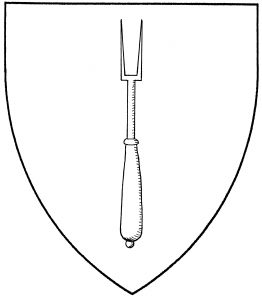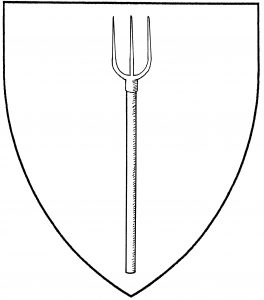A fork is an implement with two or more prongs at one end. There are several varieties of fork; while no type has been explicitly ruled to be the Society’s default, the “eating fork” seems to take that honor. The eating fork was used by diners in Italy in the 16th Century, though its use doesn’t seem to have spread before the end of period (being adopted in England only in Stuart times) [Paston-Williams, The Art of Dining, pp.75, 170]. In period, the eating fork typically had only two tines, and this is the Society default; the number of tines is nonetheless often explicitly blazoned. Though a period artifact, we have no examples of its use as a period heraldic charge; the illustration is based on a drawing by Bartolomeo Scappi, 1570 [Thornton, The Italian Renaissance Interior, pl.88].
The “hayfork” (also called the “pitchfork” or “mowing fork”) is used as a farm tool. Period heraldic examples might have either two or three prongs: two-pronged hayforks are found in the canting arms (German Gabel, “fork”) of von Gabelthofen, 1605 [Siebmacher 86], while three-pronged hayforks are found in the canting arms (German Heu, “hay”) of Hawstorffer, mid-16th C. [NW 58]. The illustration shows the three-pronged hayfork.
The heads of forks are also occasionally found as period charges. The “hayfork head” is found in the canting arms of von der Gabel, 1605 [Siebmacher 149].
All of these fork variants have their prongs to chief by default. For related charges, see eel-fork, handgun rest, mash rake, pall, streitgabelklinge, trident. See also spoon.
Uilleam Thorken Hardhans bears: Azure, three two-tined eating forks Or, on a chief argent three sets of three passion nails in pall inverted conjoined at their heads sable.
Cerdic Cenfrithes sunu bears as a badge: Gules, an eating fork bendwise sinister argent.
Andrew of the North Shore bears: Per fess raguly argent and vert, in saltire a wooden-handled spade and a two-pronged mowing fork sable, hafted proper.
Gregory of Devon bears: Gules, a hayfork erect within a bordure rayonny Or.

